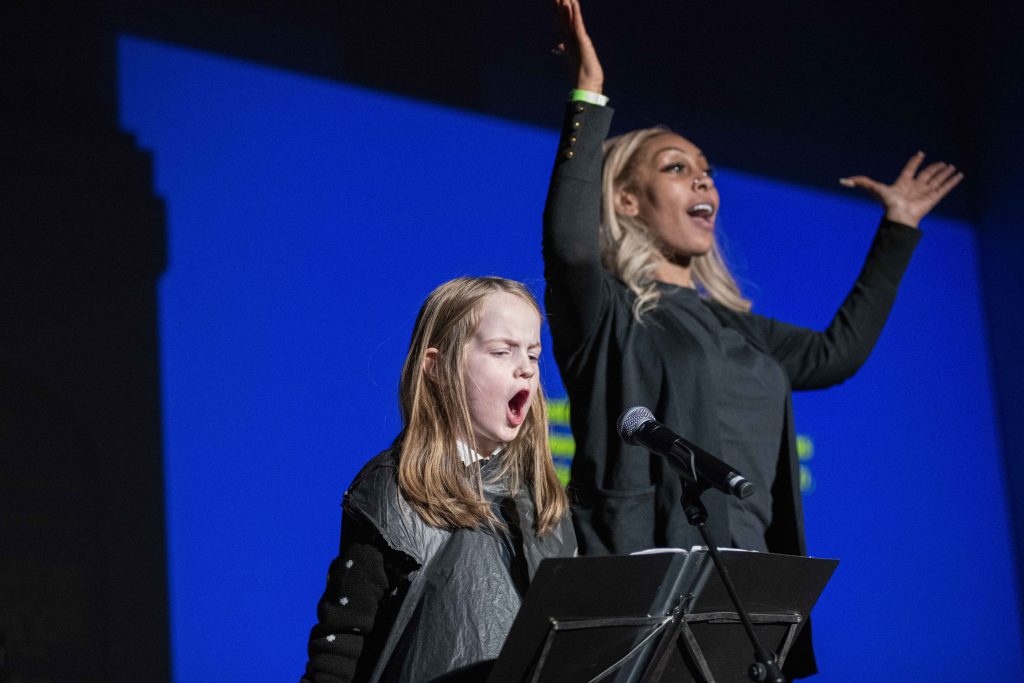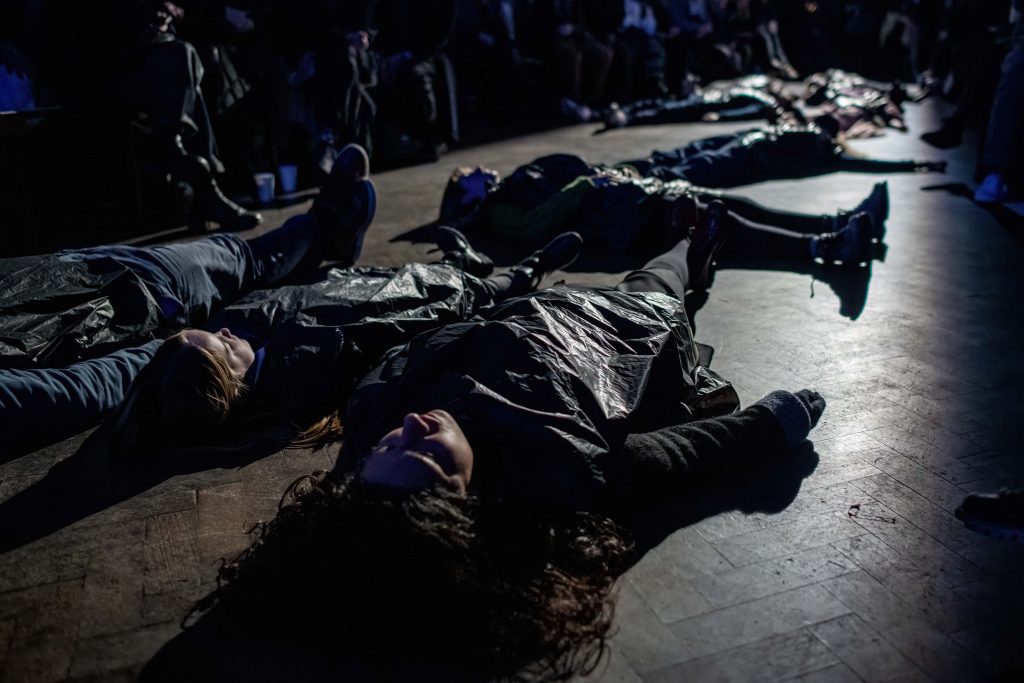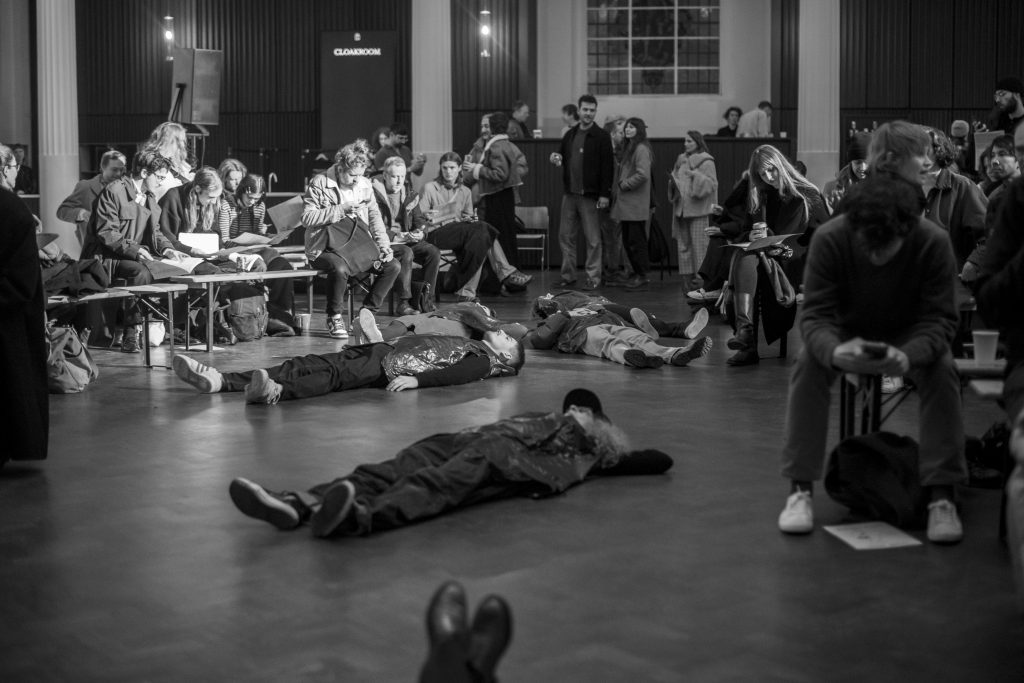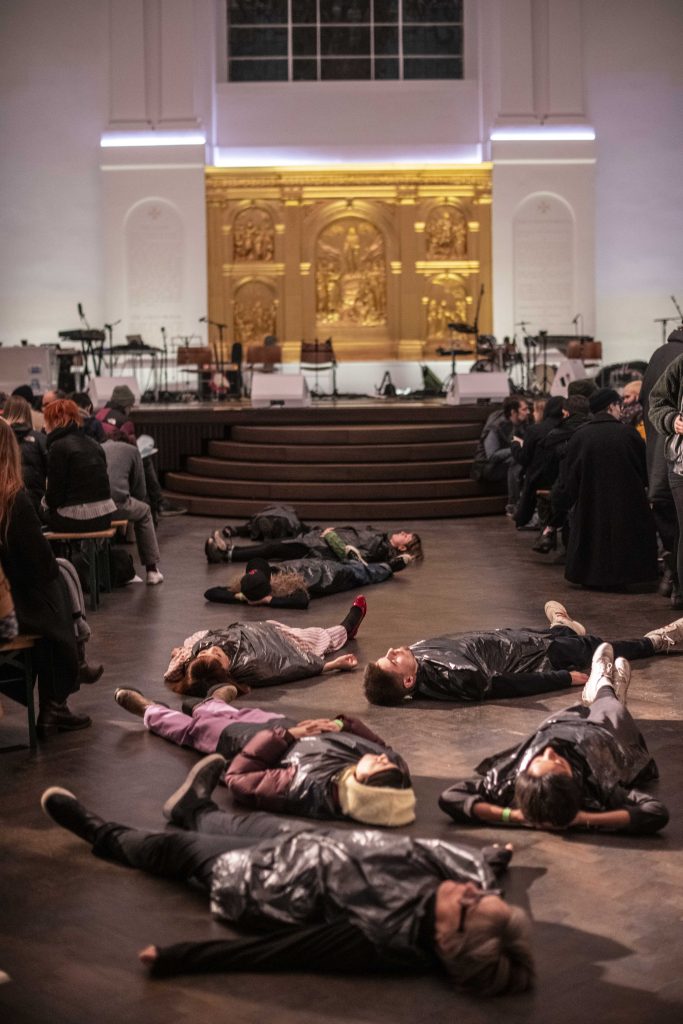
LCMF: Russell Haswell’s The Truth Is As Elusive As Ever – A Daring Trash Opera
by Ushara Dilrukshan
This year’s London Contemporary Music Festival (LCMF) transformed St John’s Church in Hackney into a hub of experimental sound, culminating in a stunning finale at Wigmore Hall on January 17th with Éliane Radigue’s OCCAM DELTA XXIII. In this review we delve into two highlights: Russell Haswell’s provocative The Truth Is As Elusive As Ever and the festival’s dynamic opening night, capturing the innovation and intensity that define LCMF.
Ushara Dilrukshan is a performance and sound artist and the host of Twilight Zone, a radio show on Rough Radio dedicated to experimental and avant-garde music. Through her writing, she explores the experience of sound, offering thoughtful and immersive reviews of contemporary works.

LCMF: Russell Haswell’s The Truth Is As Elusive As Ever (Part 1)
Two blue screens projected upon the walls of Hackney Church. I walk into trash bags scattered across the floor, only to take a closer look, realising they are repetitive bodies strewn across the ground, like driftwood along the Thames. Bodies which remained glued to the cold church floor, static in motion, lacking a tide, almost built into the architecture through their stillness. Who are these bodies, what will they come to represent, I ask myself.
‘I position myself on the catwalk close enough to one side of where the audience will be so that I can’t be ignored. I lie down and shift for a second to find a position in which I can be still and unmoving. There are four of us who form a human sculpture on the floor; we become architecture. We will be here for at least half an hour. Still. This stillness gives me a chance to think and be present in anticipation of the piece.
I am most keenly aware of my eyes. I have decided it would be best to keep them open, closing them would make things too easy for myself and the audience. As much as I want to fossilise entirely into architecture and become an object in this space, I am aware of how much my eyes inadvertently humanise me and make me representational, readable as narrative.’
— Reuben Esterhuizen; member of Musarc
As we prepare ourselves within the space for the performance, I take a seat on the floor, my friend sitting a foot’s distance away from a trash bag. Upon my earlier realisation, I drag him back, understanding that these bags are not mere sculptures but are breathing, listening, conscious, aware and will awaken and form part of this ‘Trash Opera’. More people begin to enter the space, awaiting the opening performance for the London Contemporary Music Festival 2024.
‘As people enter, I can feel the wind on my face and my fingers as air fills the vacuum left by their legs moving past me. A part of me is proud to be perceived as almost inhuman now. As more people wander into the space and look for seats, I am peripherally aware of glances and stares. Photographs being taken. Curiosity. I think of people who I know are coming. Have they already sat down? Have they seen me? What will they think of my performance? Laurence Crane enters my vision with a smile, peering down at me as he walks by. In surprise, my eyes dart after him, but he’s already left my field of view. I have betrayed my humanity.’
— Reuben Esterhuizen; member of Musarc
Russell Haswell, an avant-garde experimental musician and noise artist, brought his raw boundary-pushing aesthetic to the LCMF with The Truth Is As Elusive As Ever, a daring Trash Opera. Known for his visceral soundscapes and anti-establishment ethos explored through the relationship between technology, sound, and art, the premiere of this new work upheld his critiques on consumerism and cultural decay through chaotic, immersive composition, with influences from punk, industrial music and avant-garde figures like John Cage. A world is built with the knowledge that ‘Only music can surround us with a continuous and homogenous world of sound; a foreign world to what we call real life’. ¹
The blue screen glitches to read its first queue.
Anya (soprano): A young scientist desperate for solutions.
General Petrov (Bass): A hardened military leader haunted by past conflicts.
The chaos: A collective voice representing the people and their emotions, ranging from despair to defiance.
‘After twenty-five or so minutes, despite my architectural aspirations, my body began asserting itself. I became intensely aware of my mucus, and I swallow much more than I would have liked. The part of my skull in contact with the floor starts to ache. Despite myself, I start performing that small dance of recovering comfort. Tiny head movements to rest the bumps of my skull touching the floor, making a fist for a second to warm my hand; first one, then the other. After muttering a stanza of an unsung aria, I got up with the others and started pacing back and forth on the aisle, now illuminated with bright light, waiting for my cue to sing out my designated phrase in monotone.’
— Reuben Esterhuizen; member of Musarc
The light builds and intensifies upon the church aisle, calling for our attention. A monotonous drone of voices builds amongst scattered tonalities, slightly drowned by the rustling trash bags as the chorus awakes from their slumber and assumes a position within the church aisle. The delicate crinkles echo through the speculative world now formed within Hackney Church, cutting through monotonous prayers of divinity as audible shapes made of intervals and harmonies accent themselves. The chorus, a diverse array of trash bodies, pace in a conveyor belt motion through the church aisle, each body with dead eyes, failing to make contact with each other, almost as vessels of the story, nothing more but accents of the story surrounded by the present atonality built through their voices. The chorus of trash bodies builds in pace in random arrangements, speeding up, then slowing down, some faster than others, some falling behind, all stuck in this conveyor motion. ‘Just as we design the environment, so do our environments reconfigure who we are and what we will become’. ²
We are the chorus stuck in the cyclical motion of events, of procedures, of happenings past and present.
A wall of hedonic noise builds through the church filled with shattered computer noise, juxtaposing the previous monotonous vocality of the chorus of storytellers. Suddenly, the trash bodies begin to fall like birds struck mid-flight, falling limp to the floor. As if gravity is taking effect for the first time, the trash bodies drop and raucously crawl across the floor, dragging their bodies in pain and speeding out of the main floor.

A light appears within the noise, highlighting a new body, a formed body, a fitted body, distant from the chorus of trash, she stands against the altar, speaking a new language. She speaks physically in signs, her hands emote. What is she saying above this noise? Does the chorus know? Do I know? Does anybody know?
The blue screen glitches again to read:
‘The act opens with an orchestral lament, reflecting the bleakness of the world. Anya enters, clutching a worn data pad.’
The chorus re-appear on the balcony of the church, and the body of voices eventually forms coherent and cognitive vocalisations of falling motifs, creating this uneasiness within the space, again juxtaposing the soft synthesised sounds and reinforced by the repetitive atonal chorus motif from the leader for the chorus. The chorus use their choreographed voices to echo through the church amidst these soft, harmonising, synthesised organ notes.
‘The spell of the performance for me was broken as we left the hall to climb the stairs up to the balcony of the church, taking our place around the bannisters for the next part of the piece. In the liminal space between the concert hall and the balcony, we exchanged grins and brief chatter, most of us feeling a mutual confusion as to whether we were doing any of it ‘right’. The balcony section involved a lot of shouting and vocal glissandi and more text that I couldn’t remember. I felt quite disconnected from the world the opera was trying to put across and couldn’t make my way into the libretto, although I recognised it was probably purposefully opaque.’
— Reuben Esterhuizen; member of Musarc
The blue screen glitches once more to read:
‘The chaos hesitates, then a single voice rises, in hesitant agreement. Soon, more voices join until a powerful chorus of hope fills the air.’
As the chorus hesitates, a voice takes centre stage below it all. A voice of a small human. A child. A child reading from scripture, a child preaching our future, our way to utopia, our way out.
‘There was something so transfixing and beautiful about this tableau, partly in its absurdity: the small child reading a confusing text in the carefree, unarticulated, monotonous manner, and the grown woman beside her empathetically and formally signing the text for the audience. Something about their relationship on the stage seemed so touching, and the ending was certainly emotional.’
— Reuben Esterhuizen; member of Musarc
The world premiere of Russel Haswell’s ‘The Truth is as Elusive as ever;’ A Daring Trash Opera, working with Musarc, brought us themes of faith, belief, cultural decay and consumerism within his practice of randomness and chaos. It felt as if the queues and scenes provided were ‘summing up a set of spiritual processes taking place in the mind of the artist and in the mind of us, we received the artist’s gifts.’ ³
Chiara Dorbolo discusses that ‘storytelling could become an ally in challenging the current narrative that pits humanity against everything else’, and within this speculative trash world and suggestive hopeful ending, Russel Haswell does not fall short of proving more evidence to this case with his beautiful thought-provoking work.

LCMF: Wednesday Review (Part 2)
The London Contemporary Music Festival 2024 held in Hackney Church showcased an eclectic evening of sonic innovation, ranging from experimental compositional works to the visceral insanity of pantomime ‘garbage patch kids’ inspired noise theatre, consummating to form a rich tapestry of contemporary musical expression.
The evening began with Philip Corner’s ‘During This Concert, the hall will be bombed – or blown up‘, a UK premiere, which, due to unforeseen circumstances, was cancelled, along with his later premieres of ‘An anti-personnel CBU-Type cluster bomb unit will be thrown into the audience‘; and ‘As soon as I finish speaking this hall will be struck by an intercontinental long-range rocket‘. The titles of these pieces speak a thousand words about our current political climate, leaving us with a lack of ‘the impression of the peace of music being co-ordinated as a whole, and instead providing us with a selection of disconnected fragments’.⁴ Fragments which we can think upon and draw conclusions from, mirroring present realities. Perhaps we are privileged for those unforeseen circumstances.
Following Corner, composer Laurie Tompkins and saxophonist Sam Andreae performed The Falmouth Greeny, ‘where omnicringe and shitpost modernism met’. The piece utilised extended playing techniques, and although confined to a small stage at the rear left of the church, the artists were connected to the space, running between the crowd, crumpling and scratching paper, generating delicate textures of sound in motion amidst vocal breaks.
The Viola Torros premiered New Sound Fragments, a piece in which delicate strings echoed throughout the space, bringing people back into themselves and allowing them the pleasure to cease being conscious of themselves. Instead, they acknowledged the feeling of being played upon, like strings gently caressed, circulating like whispers through the space with drone qualities reminiscent of a distant culture through alternate modes. As the lights dimmed, I found myself engaging with the practice of deep perception. Deep perception is a process of ‘less reaching out to the world, less production, less doing and more listening. It’s a multi-sensorial way to practice deep listening’ as suggested by Alice Van Der Wienlen-Honick. Each musician softly touched their strings, playing themselves deep into a trance, becoming slaves to their bows following the movements of the notes, subsequently allowing the audience ‘to follow each note, feeling its relation with others’, which for me enhanced the practice of deep listening by not only feeling all the notes but also their relations.⁵
After a brief interval and a set change, Adam de la Cour graced the main Church stage with Groyne ’n’ Goosed, featuring Santa Claus in PJs and an MF Doom-style mask, horrendously wrapped from head to toe, ready to present himself within his experimental noisemas piece. The work was a comic theatrical gag of performance and video work, tackling themes of overconsumption and mass production within the digital age, reinforced through runs of brief acts creating a lifelike ‘scrolling through the feed’ with absurd interactive storytelling unfolding before our eyes.
Absurdity following absurdity, Hackney Church was transported to the infamous Art Basel event space by Jennifer Walshe with A Glimpse of the Art Basel from The Text Score Dataset 1.0. Walshe provided Musarc with odd, contradictory and comedic instructions generated from a dataset of over 3,000 text scores. The piece consisted of hauntingly pretentious laughs, stares and gasps.
“Instructions: performers may synchronise either their timbres or their duration. Instructions: performers should synchronise their duration and either their timbres or their duration.”
— Excerpt from Walshe’s Text Scores
To close the night, Aya, an electronic producer—the 44th Aya listed on Discogs – played the music of the 43 Ayas who preceded her, consisting of a compilation of Aya’s music squished into mere seconds. She walked up with her hood on, hiding her face, backpack on, just as if straight out of a rave. Preceding this performance, she opened with deep broken electronic bass reverberations of pain and lost notes scattered with spoken words. She opened herself up, allowing us to, what felt like, explore a journey through her mind. Within these computerised elongated soundscapes with powerful kicks and glitching-out synthesisers, there were these beautifully broken fragments of sound interlaced with soft sections and spoken word openings, which made it feel like she was talking to herself, opening up and being real, almost like it was the most real moment of her life. Like there isn’t another time when she’s more truthful; she is here now on this stage; she presents herself in front of us; this is it. ‘Is it such a curse for a woman to want to play her music in a church?’, she says.
The work felt like a piece which cultivated a deep energy of underground youth culture, with topics covering drugs and reality, infused with this dark satirical humorous energy. This was refreshing, especially combined with delicate crushing synths.
“Maybe it’s not the imagination; maybe it’s the will to breathe things into reality.”
— Aya
The LCMF breathed into reality absurd performances and experimental works, continuing to push the boundaries of sound and contemporary music, asserting its place as a bold and transformative platform for avant-garde music and performance art. The festival remains an unmissable celebration of artistic exploration and creativity and concludes with its final performance on January 17th at Wigmore Hall with a rare performance of Éliane Radigue & The Orchestra of Futurist Noise Intoners.
Ushara Dilrukshan
Notes & References
- Vernon Lee, Music and Its Influence on the Mind.
- Vernon Lee, Architecture, Design, and Human Perception.
- Chiara Dorbolo, The Power of Storytelling in Contemporary Art.
- Vernon Lee, Fragments and Musical Cohesion in Contemporary Performance.
- Alice Van Der Wienlen-Honick, Deep Perception and Listening in Sonic Practices.

Back to home.